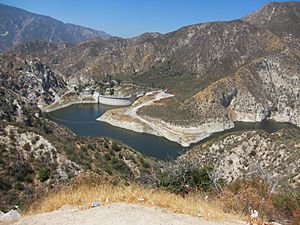Big Tujunga Dam facts for kids
Quick facts for kids Big Tujunga Dam |
|
|---|---|

View of the dam and reservoir from upstream
|
|
| Country | United States |
| Location | Angeles National Forest, Los Angeles County, California |
| Coordinates | 34°17′36″N 118°11′18″W / 34.29333°N 118.18833°W |
| Opening date | 1931 |
| Owner(s) | Los Angeles Department of Water and Power |
| Dam and spillways | |
| Type of dam | Concrete arch |
| Impounds | Big Tujunga Creek |
| Height | 208 ft (63 m) |
| Height (foundation) | 244 ft (74 m) |
| Length | 830 ft (250 m) |
| Spillway type | Concrete-lined overflow |
| Spillway capacity | 90,000 cu ft/s (2,500 m3/s) |
| Reservoir | |
| Creates | Big Tujunga Reservoir |
| Total capacity | 5,960 acre⋅ft (7,350,000 m3) |
| Catchment area | 82 sq mi (210 km2) |
The Big Tujunga Dam is a large concrete arch dam in Los Angeles County, California. It stands about 244 feet (74 meters) tall. The dam crosses Big Tujunga Creek in Big Tujunga Canyon, which is northeast of Sunland. This area is in the foothills of the San Gabriel Mountains.
The dam was finished in 1931. Its main jobs are to control floods and help refill underground water supplies (called groundwater recharge) for the San Fernando Valley. The lake behind the dam is called Big Tujunga Reservoir. It collects water from a large area of 82 square miles (212 square kilometers). Even though it's in the Angeles National Forest, people are not allowed to visit the lake. The water level is usually kept low to make space for winter floods. The name "Tujunga" comes from a Tongva village name.
Contents
About the Big Tujunga Dam
The Big Tujunga Dam is 208 feet (63 meters) high from the riverbed. From its very foundations, it is 244 feet (74 meters) tall. The dam stretches 830 feet (250 meters) long. It is 138 feet (42 meters) wide at its base and gets narrower to 8 feet (2.4 meters) at the top.
How the Dam Helps the Community
The reservoir can hold about 5,960 acre-feet (7.35 million cubic meters) of water. A small amount of water, about 1,210 acre-feet (1.49 million cubic meters), is always kept in the reservoir. This helps stop dirt and rocks from getting into the dam's pipes.
After the Hansen Dam was built further downstream, the Big Tujunga Dam became less important for flood control. However, it still protects about 4,600 people who live in the floodplain of Big Tujunga Canyon. The dam also saves about 4,500 acre-feet (5.6 million cubic meters) of water each year. This water is used for drinking and refilling groundwater. This saves Los Angeles about $2.25 million every year.
Dealing with Sediment and Fires
The reservoir is not very big compared to the area it collects water from. This means that dirt and mud often build up behind the dam. Workers have to regularly remove this sediment. Most of it is pressed together and stored nearby.
In 2009, a large wildfire called the Station Fire burned most of the Big Tujunga watershed. This fire caused over 2 million cubic yards (1.5 million cubic meters) of sediment to flow into the reservoir. All of this material had to be removed later.
History of Big Tujunga Dam
The area around the dam and Big Tujunga Canyon has a rich history. A Tongva village called Tujunga or Tuxunga was once located here. Its name means "old woman's place." Another village, Muxúnga, meant "place of shooting" in the Fernandeño dialect of the Tongva language.
Building the Dam
The Los Angeles Department of Water and Power finished building the dam in 1931. It cost $1.2 million at that time. The dam was first called Big Tujunga Dam No. 1. This was because other flood control dams were planned for the canyon. However, when the larger Hansen Dam was completed in 1940, the other dams were no longer needed.
During the Los Angeles flood of 1938, the Big Tujunga Dam played a crucial role. It stopped a huge flow of rocks and trees. This saved much of Sunland, Tujunga, and Glendale from being destroyed.
Dam Upgrades and Safety
In 1976, experts realized the dam could be at risk from earthquakes. The San Andreas Fault is located nearby. Because of this, the reservoir's water level was temporarily kept very low.
In 2008, a big project began to make the dam stronger. About 75,000 cubic yards (57,000 cubic meters) of concrete were added. This changed the dam from a thin-arch to a thick-arch design. A new spillway was built, and the old one was made larger. This increased the dam's ability to handle floodwater from 23,000 cubic feet per second (650 cubic meters per second) to over 90,000 cubic feet per second (2,500 cubic meters per second). A special valve was also installed at the dam's base. This valve helps release small amounts of water to protect the local habitat. This major upgrade project was finished in July 2011 and cost $100 million.
Images for kids


